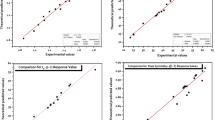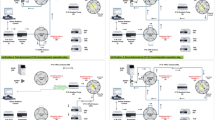Abstract
The study deals with the optimization of reverse-phase HPLC separation of cis-/trans- isomers of long-chain unsaturated fatty acids by the assessment of the central composite design (CCD) of response surface methodology (RSM). The optimized conditions were also applied for the analysis of fatty acids in functional cold-pressed oils. The data obtained from experimental applications of CCD was used to model the parameters that significantly affect separations. The independent variables chosen were flow rate (X 1 ), column temperature (X 2 ), and acetonitrile content in mobile phase (X 3 ). A second-order polynomial model was used to estimate the impact of variables on separation efficiencies of the C30 and C18 stationary phases. The proposed CCD models were also validated with the ANOVA. The predicted values were in good agreement with experimental data, advising expert application of CCD as an option to obtain maximum information for the modeling of reverse-phase HPLC separation with little number of experiments. The optimal values of method parameters for the efficient C18 and C30 column separations as part of the k′ response value were found to be flow rate of 1.10 and 0.42 mL min−1, temperature of 3.6 and 9.4 °C, and acetonitrile content in mobile phase of 100 and 77.4%, respectively. ANOVA test results also illustrate that the CCD models can be successfully used to predict the optimum method parameters. To maximize both sensitivity and precision of the methods, the validation procedure was also performed and the higher correlation coefficients (r = 0.9149–0.9993) were determined for all fatty acid methyl esters. Thus, the proposed experimental designs were shown to offer considerable advantages over traditional method optimization approaches.





Similar content being viewed by others
References
Adlof RO (2004) Separation of conjugated linoleic acid methyl esters by silver-ion high performance liquid chromatography in semi-preparative mode. J Chromatogr A 1033:369–371
Ahmed M, Akter MSTS, Eun J (2011) Optimization conditions for anthocyanin and phenolic content extraction form purple sweet potato using response surface methodology. Int J Food Sci Nutr 62(1):91–96
Asadollahzadeh M, Tavakoli H, Torab-Mostaedi M, Hosseini G, Hemmati A (2014) Response surface methodology based on central composite design as a chemometric tool for optimization of dispersive-solidification liquid–liquid micro-extraction for speciation of inorganic arsenic in environmental water samples. Talanta 123:25–31
Aveldano MI, Van Rollis M, Horrocks LA (1983) Separation and quantitation of free fatty acids and fatty acid methyl esters by reverse phase high pressure liquid chromatography. J Lipid Res 24:83–93
Bailey AL, Southon S (1998) Determination of total long-chain fatty acids in human plasma and lipoproteins, before and during copper-stimulated oxidation, by high-performance liquid chromatography. Anal Chem 70:415–419
Benitez-Sanchez PL, Leon-Camacho M, Aparicio R (2003) A comprehensive study of hazelnut oil composition with comparisons to other vegetable oils, particularly olive oil. Eur Food Res Technol 218:13–19
Bravi E, Perretti G, Montanari L (2006) Fatty acids by high-performance liquid chromatography and evaporative light-scattering detector. J Chromatogr A 1134:210–214
Brereton RG (1997) Multilevel multifactor designs for multivariate calibration. Analyst 122:1521–1529
Chen S, Chuang Y (2002) Analysis of fatty acids by column liquid chromatography. Anal Chim Acta 465:145–155
Christie WW, Dobson G, Adlof RO (2007) A practical guide to the isolation, analysis and identification of conjugated linoleic acid. Lipids 42:1073–1084
Coleman J, Wrzosek T, Roman R, Peterson J, McAllister P (2001) Setting system suitability criteria for delectability in high-performance liquid chromatography methods using signal-to-noise ratio statistical tolerance intervals. J Chromatogr A 917:23–27
Delmonte P, Hu Q, Kia ARF, Rader JI (2008) Preparation, chromatographic separation and relative retention times of cis/trans heptadecaenoic (17:1) fatty acids. J Chromatogr A 1214:30–36
European Union Commission EEC 2568/91 (1991) Characteristics of olive and olive pomace oils and their analytical methods. Off J Eur Communities L 248:1–82
Funazo K, Tanaka M, Yasaka Y, Takigawa H, Shono T (1989) New ultraviolet labelling agents for high-performance liquid chromatographic determination of monocarboxylic acids. J Chromatogr A 481:211–219
Gutnikov G (1995) Fatty acid profiles of lipid samples. J Chromatogr B Biomed Sci Appl 671:71–89
Joint FAO/WHO Food Standards Programme Codex Alimentarius Commission (2001) Report of the 17th Session of the Codex Alimentarius Committee on Fats and Oils. 19 – 23 February 2001, London, U.K
Juanéda P (2002) Utilisation of reversed-phase high-performance liquid chromatography as an alternative to silver-ion chromatography for the separation of cis- and trans-C18:1 fatty acid isomers. J Chromatogr A 954:285–289
Kofroňová E, Cvačka J, Vrkoslav V, Hanus R, Jiroš P, Kindl J, Hovorka O, Valterová I (2009) A comparison of HPLC/APCI-MS and MALDI-MS for characterising triacylglycerols in insects: species-specific composition of lipids in the fat bodies of bumblebee males. J Chromatogr B 877:3878–3884
Lacaze JCL, Stobo LA, Turrell EA, Quilliam MA (2007) Solid-phase extraction and liquid chromatography–mass spectrometry for the determination of free fatty acids in shellfish. J Chromatogr A 1145:51–57
Lee TZE, Krongchai C, Lu NA, Lu MI, Kittiwachana S, Sim SF (2015) Application of central composite design for optimization of the removal of humic substances using coconut copra. Int J Ind Chem 6:185–191
Li C, Yao Y, Zhao G, Cheng W, Liu H, Liu C, Shi Z, Chen Y, Wang S (2011) Comparison and analysis of fatty acids, sterols, and tocopherols in eight vegetable oils. J Agric Food Chem 59:12493–12498
Lima ES, Abdalla DSP (2002) High-performance liquid chromatography of fatty acids in biological samples. Anal Chim Acta 465:81–91
Lísa M, Holčapek M (2008) Triacylglycerols profiling in plant oils important in food industry, dietetics and cosmetics using high-performance liquid chromatography–atmospheric pressure chemical ionization mass spectrometry. J Chromatogr A 1199:115–130
Lundstedt T, Seifert E, Abramo L, Thelin B, Nyström Å, Pettersen J, Bergman R (1998) Experimental design and optimization. Chemometr Intell Lab 42:3–40
Makahleh A, Saad B, Siang GH, Saleh MI, Osman H, Salleh B (2010) Determination of underivatized long chain fatty acids using RP-HPLC with capacitively coupled contactless conductivity detection. Talanta 81:20–24
Mansour MP (2005) Reversed-phase high-performance liquid chromatography purification of methyl esters of C16–C28 polyunsaturated fatty acids in microalgae, including octacosaoctaenoic acid [28:8(n-3)]. J Chromatogr A 1097:54–58
Molnár-Perl I (2000) Role of chromatography in the analysis of sugars, carboxylic acids and amino acids in food. J Chromatogr A 891:1–32
Obert JC, Hughes D, Sorenson WR, McCann M, Ridley WP (2007) A quantitative method for the determination of cyclopropenoid fatty acids in cottonseed, cottonseed meal, and cottonseed oil by high-performance liquid chromatography. J Agric Food Chem 55:2062–2067
Rezanka T (2000a) Analysis of polyunsaturated fatty acids using high performance liquid chromatography–atmospheric pressure chemical ionization mass spectrometry. J High Resolut Chromatogr 23:338–342
Rezanka T (2000b) Analysis of very long chain polyunsaturated fatty acids using high-performance liquid chromatography–atmospheric pressure chemical ionization mass spectrometry. Biochem Syst Ecol 28:847–856
Rioux V, Catheline D, Bouriel M, Legrand P (1999) High performance liquid chromatography of fatty acids as naphthacyl derivatives. Analusis 27:186–193
Ruiz-Rodriguez A, Reglero G, Ibanez E (2010) Recent trends in the advanced analysis of bioactive fatty acids. J Pharm Biomed Anal 51:305–326
Siang GH, Makahleh A, Saad B, Lim BP (2010) Hollow fiber liquid-phase microextraction coupled with gas chromatography-flame ionization detection for the profiling of fatty acids in vegetable oils. J Chromatogr A 1217:8073–8078
Trevisan AJB, Arêas JAG (2012) Development of corn and flaxseed snacks with high-fibre content using response surface methodology (RSM). Int J Food Sci Nutr 63(3):362–367
Tsuyama Y, Uchida T, Goto T (1992) Analysis of underivatized C12–C18 fatty acids by reversed-phase ion-pair high-performance liquid chromatography with conductivty detection. J Chromatogr A 596:181–184
Validation of analytical procedures: text and methodology (2005) Complementary Guideline on Methodology
Van Ruth SM, Villegas B, Akkermans W, Rozijn M, van der Kamp H, Koot A (2010) Prediction of the identity of fats and oils by their fatty acid, triacylglycerol and volatile compositions using PLS-DA. Food Chem 118:948–955
Villegas C, Zhao Y, Curtis J (2010) Two methods for the separation of monounsaturated octadecenoic acid isomers. J Chromatogr A 1217:775–784
Vioque E, Maza MP, Millan F (1985) High-performance liquid chromatography of fatty acids as their p-phenylazophenacyl esters. J Chromatogr A 331:187–192
Vrkoslav V, Urbanová K, Cvačka J (2010) Analysis of wax ester molecular species by high performance liquid chromatography/atmospheric pressure chemical ionisation mass spectrometry. J Chromatogr A 1217:4184–4194
Walia A, Mehta P, Guleria S, Shirkot CK (2015) Improvement for enhanced xylanase production by Cellulosimicrobium cellulans CKMX1 using central composite design of response surface methodology. 3 Biotech 5:1053–1066
Wang XY, Wang HL, Liu YJ, You JM, Suo YR (2009) Extraction of pollen lipids by SFE-CO2 and determination of free fatty acids by HPLC. Eur J Lipid Sci Technol 111:155–163
Winkler K, Steinhart H (2001) Identification of conjugated isomers of linolenic acid and arachidonic acid in cheese. J Sep Sci 24:663–668
Wood R, Lee T (1983) High-performance liquid chromatography of fatty acids: quantitative analysis of saturated, monoenoic, polyenoic and geometrical isomers. J Chromatogr A 254:237–246
Wu Z, Zhang Q, Li N, Pu Y, Wang B, Zhang T (2016) Comparison of critical methods developed for fatty acid analysis: a review. J Sep Sci 40:1–11
Yasaka Y, Tanaka M, Shono T, Tetsumi T, Katakawa J (1990) 2-(2,3-Naphthalimino)ethyl trifluoromethanesulphonate as a highly reactive ultraviolet and fluorescent labelling agent for the liquid chromatographic determination of carboxylic acids. J Chromatogr A 508:133–140
Funding
The present study was supported by Karamanoglu Mehmetbey University (Karaman, Turkey) Scientific Research Project Centre with 14-M-16 project number.
Author information
Authors and Affiliations
Corresponding author
Ethics declarations
Conflict of Interest
Fatma Nur Arslan declares that she has no conflict of interest. Hacer Azak declares that she has no conflict of interest.
Ethical Approval
All procedures performed in studies involving human participants were in accordance with the ethical standards of the institutional and/or national research committee and with the 1964 Helsinki declaration and its later amendments or comparable ethical standards.
Informed Consent
Informed consent was obtained from all individual participants included in the study.
Electronic supplementary material
Supplementary Figure 1
(DOCX 1.05 mb)
Supplementary Figure 2
(DOCX 970 kb)
Supplementary Table 1
(DOCX 34 kb)
Rights and permissions
About this article
Cite this article
Arslan, F.N., Azak, H. Application of Central Composite Design for the Optimization of Reverse-Phase HPLC/DAD Separation of the cis- and trans- Isomers of Long-Chain Unsaturated Fatty Acids. Food Anal. Methods 11, 1163–1179 (2018). https://doi.org/10.1007/s12161-017-1073-1
Received:
Accepted:
Published:
Issue Date:
DOI: https://doi.org/10.1007/s12161-017-1073-1




